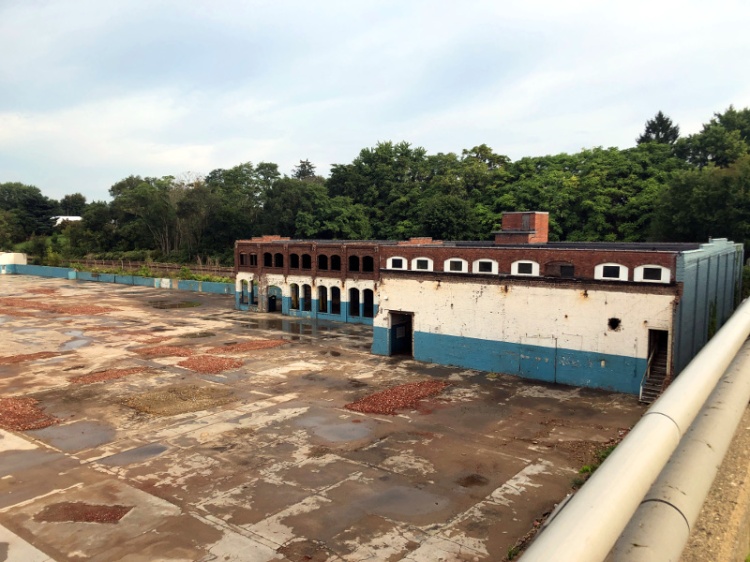While the buildings that once housed the New Philadelphia Agricultural Works of English & Dixon no longer stand, the ongoing development of the site that once hosted it gives the opportunity to examine one of the city’s earliest industrial efforts.
The location on South Broadway that once housed the Howden-Buffalo manufacturing plant has, for over a hundred and seventy years, served as an important industrial site in New Philadelphia. One of the earliest of those industrial efforts was a business that manufactured a variety of agricultural implements and shipped them nationwide. That business came to be called the English & Dixon Agricultural Machine Works, though it sometimes was shortened to merely “English & Dixon” or referred to as the “New Philadelphia Agricultural Works.”
The business was founded in 1851 when the firm, originally managed by John S. Hull (1811-1898), constructed a large shop on the west side of South Broadway, just south of the railroad tracks. The business changed hands for a few succeeding years, owners and partners came and went, and new machinery and shops were added until two of the men who who played a role in the business’ 1850s growth became the last owners. Those men were two Pennsylvania transplants, John English (1816-1889) and Thomas Dixon (1815-1890), and the business then became known as English & Dixon.
John English was born in Carlisle, Pennsylvania in 1816 and migrated to Ohio sometime in the 1840s. Once in Tuscarawas County, John established himself as a merchant in the city of New Philadelphia and married Lucinda Coventry (1825-1884) around 1844. Thomas Dixon was also born in Pennsylvania, within a year of John English, and first appears in Tuscarawas County in the 1850 census where he is noted as being a merchant in Port Washington. A few years later Thomas married Caroline Welsh (1828-1921) and the couple relocated to New Philadelphia shortly before John and Thomas began their twenty-plus year partnership in 1864.
The partners’ respective families had grown significantly by the time their partnership commenced in 1864. John and Lucinda Dixon had eight children between 1845 and 1863, six sons and two daughters; two sons and a daughter died as children. Thomas and Caroline had four children between 1855 and 1862, all daughters. As their families grew, so too did the English & Dixon business, though not without setbacks. The agricultural works suffered a catastrophic fire in the spring of 1867 causing the partners to take out loans and solicit funds from the community in order to rebuild. Given that English & Dixon employed anywhere from 50 to 120 local men at a time, depending on how business was, it made sense for the community to invest in the enterprise.
The English & Dixon Agricultural Works manufactured a number of historically significant agricultural machines including the Ball’s Reaper and Mower, later to be known as the “Keystone Mower”, and a device known as the Pitt’s Separator and Thresher. One source recorded that the firm produced 1,200 to 1,500 mowers a year. The works also produced smaller implements as well including sulky corn plows and hay rakes. English & Dixon not only served the immediate market for their goods but also shipped their tools all across the Midwest and South. References to English & Dixon, and their agricultural machinery, are found in numerous newspapers all across the region.
The English & Dixon Agricultural Machine Works included, at the height of its operation, a woodworking shop, a machine shop, blacksmith shop, foundry, and a grinding shop. The machinery was powered by a steam engine housed in its own building as well. Several other buildings surrounded the shops, including storage buildings, offices, and houses to dry wood. English & Dixon was known to ship implements and machinery to Kansas City and it was there that the English sons moved and established a successful retail hardware business that came to be known as English Brothers.
English & Dixon continued to produce farming equipment until 1883 when it became apparent that business was waning. Debts taken out in the past when business was booming came due and, despite making improvements to the property, English & Dixon were unable to remain financially afloat. Work ceased sometime after 1884 and John English, now a widower, went to live with his sons in Kansas City. John English died in Kansas City in August 1889 but was returned to New Philadelphia for burial. Thomas Dixon died a year later in the fall of 1890, after which his wife went to live with one of their married daughters in Cleveland.
None of the buildings that once housed the English & Dixon Agricultural Machine Works survive on the property that became home to a number of subsequent industries. However, it is not hard to imagine the bustling sounds of the English & Dixon steam engines and machinery, the smoke that poured from the shop and foundry chimneys, and the lines of men walking home along Broadway after a hard day’s labor.
© Noel B. Poirier, 2022.












Before it became Howden Buffalo it was Joy Manufacturing. My husband worked there till July 1985. Thanks for the story. Keep the stories coming.
LikeLike
When was the Joy Manufacturing office building built? My guess is 1946, but I could be wrong. Pop worked there for many years, although I think he worked in the factory some also.
LikeLike
My father, Harold Adams, worked first for Ladel and then Joy Mtg for 37 years until he passed away in 1971 prior to being retirement age.
LikeLike
Do you know how old the remaining buildings are on the site?
LikeLike